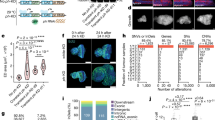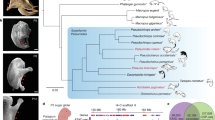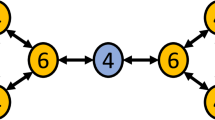Abstract
In Drosophila, the morphogen Bicoid organizes anterior patterning in a concentration-dependent manner by activating the transcription of target genes such as orthodenticle (otd)1 and hunchback (hb), and by repressing the translation of caudal2,3. Homologues of the bicoid gene have not been isolated in any organism apart from the higher Dipterans4,5,6,7. In fact, head and thorax formation in other insects is poorly understood. To elucidate this process in a short-germband insect, I analysed the function of the conserved genes orthodenticle-1 (otd-1) and hb in the flour beetle Tribolium castaneum. Here I show that, in contrast to Drosophila, Tribolium otd-1 messenger RNA is maternally inherited by the embryo. Reduction of Tribolium otd-1 levels by RNA interference (RNAi) results in headless embryos. This shows that otd-1 is required for anterior patterning in Tribolium. As in Drosophila, Tribolium hb specifies posterior gnathal and thoracic segments. The head, thorax and the anterior abdomen fail to develop in otd-1/hb double-RNAi embryos. This phenotype is similar to that of strong bicoid mutants in Drosophila. I propose that otd-1 and hb are part of an ancestral anterior patterning system.
This is a preview of subscription content, access via your institution
Access options
Subscribe to this journal
Receive 51 print issues and online access
$199.00 per year
only $3.90 per issue
Buy this article
- Purchase on Springer Link
- Instant access to full article PDF
Prices may be subject to local taxes which are calculated during checkout




Similar content being viewed by others
References
Gao, Q. & Finkelstein, R. Targeting gene expression to the head: the Drosophila orthodenticle gene is a direct target of the Bicoid morphogen. Development 125, 4185–4193 (1998)
St Johnston, D. & Nüsslein-Volhard, C. The origin of pattern and polarity in the Drosophila embryo. Cell 68, 201–220 (1992)
Lall, S. & Patel, N. H. Conservation and divergence in molecular mechanisms of axis formation. Annu. Rev. Genet. 35, 407–437 (2001)
Sommer, R. & Tautz, D. Segmentation gene expression in the housefly Musca domestica. Development 113, 419–430 (1991)
Schröder, R. & Sander, K. A comparison of transplantable bicoid activity and partial bicoid homeobox sequences in several Drosophila and blowfly species (Calliphoridae). Wilhelm Roux Arch. Dev. Biol., 203, 34–43 (1993)
Stauber, M., Jäckle, H. & Schmidt-Ott, U. The anterior determinant bicoid of Drosophila is a derived Hox class 3 gene. Proc. Natl Acad. Sci. USA 96, 3786–3789 (1999)
Brown, S. J. et al. A strategy for mapping bicoid on the phylogenetic tree. Curr. Biol. 11, R43–R44 (2001)
Dubnau, J. & Struhl, G. RNA recognition and translational regulation by a homeodomain protein. Nature 379, 694–699 (1996)
Rivera-Pomar, R., Niessing, D., Schmidt-Ott, U., Gehring, W. J. & Jäckle, H. RNA binding and translational suppression by bicoid. Nature 379, 746–749 (1996)
Simpson-Brose, M., Treisman, J. & Desplan, C. Synergy between the hunchback and bicoid morphogens is required for anterior patterning in Drosophila. Cell 78, 855–865 (1994)
Dearden, P. & Akam, M. Axial patterning in insects. Curr. Biol. 9, R591–R594 (1999)
Wimmer, E., Carleton, A., Harjes, P., Turner, T. & Desplan, C. bicoid-independent formation of thoracic segments in Drosophila. Science 287, 2476–2479 (2000)
Tautz, D., Friedrich, M. & Schröder, R. Insect embryogenesis—what is ancestral and what is derived? Development, (Suppl.), 193–199 (1994)
Cohen, S. & Jürgens, G. Drosophila headlines. Trends Genet. 7, 267–272 (1991)
Li, Y. et al. Two orthodenticle-related genes in the short-germ beetle Tribolium castaneum. Dev. Genes Evol. 206, 35–45 (1996)
Brown, S. J., Mahaffey, J., Lorenzen, M., Denell, R. & Mahaffey, J. Using RNAi to investigate orthologous homeotic gene function during development of distantly related insects. Evol. Dev. 1, 11–15 (1999)
Bucher, G., Scholten, J. & Klingler, M. Parental RNAi in Tribolium (Coleoptera). Curr. Biol. 12, R85–R86 (2002)
Frohnhöfer, H. G. & Nüsslein-Volhard, C. Organization of anterior pattern in the Drosophila embryo by the maternal gene bicoid. Nature 324, 120–125 (1986)
Wolff, C., Sommer, R., Schröder, R., Glaser, G. & Tautz, D. Conserved and divergent expression aspects of the Drosophila segmentation gene hunchback in the short germ band embryo of the flour beetle Tribolium. Development 121, 4227–4236 (1995)
Falciani, F. et al. Class 3 Hox genes in insects and the origin of zen. Proc. Natl Acad. Sci. USA 93, 8479–8484 (1996)
Lehmann, R. & Nüsslein-Volhard, C. hunchback, a gene required for segmentation of an anterior and posterior region of the Drosophila embryo. Dev. Biol. 119, 402–417 (1987)
Pultz, M., Pitt, J. & Alto, N. Extensive zygotic control of the anteroposterior axis in the wasp Nasonia vitripennis. Development 126, 701–710 (1999)
Niessing, D. et al. Homeodomain position 54 specifies transcriptional versus translational control by Bicoid. Mol. Cell 5, 395–401 (2000)
Draper, B. W., Mello, C. C., Bowerman, B., Hardin, J. & Priess, J. R. MEX-3 is a KH domain protein that regulates blastomere identity in early C. elegans embryos. Cell 87, 205–216 (1996)
Isaacs, H., Andreazzoli, M. & Slack, J. Anteroposterior patterning by mutual repression of orthodenticle and caudal-type transcription factors. Evol. Dev. 1, 143–152 (1999)
Gamberi, C., Peterson, D. S., He, L. & Gottlieb, E. An anterior function for the Drosophila posterior determinant Pumilio. Development 129, 2699–2710 (2002)
Lall, S., Ludwig, M. Z. & Patel, N. H. nanos plays a conserved role in axial patterning outside of the Diptera. Curr. Biol. 13, 224–229 (2003)
Patel, N. et al. Grasshopper hunchback expression reveals conserved and novel aspects of axis formation and segmentation. Development 128, 3459–3472 (2001)
Stauber, M., Prell, A. & Schmidt-Ott, U. A single Hox3 gene with composite bicoid and zerknüllt expression characteristics in non-Cyclorrhaphan flies. Proc. Natl Acad. Sci. USA 99, 274–279 (2002)
Fire, A. et al. Potent and specific genetic interference by double-stranded RNA in Caenorhabditis elegans. Nature 391, 806–811 (1998)
Acknowledgements
I thank T. Mader for excellent technical assistance, A. Beermann, H. Dove, F. Maderspacher, R. Reuter and C. Wolff for critically reading drafts of the manuscript, E. A. Wimmer for discussions and for pointing out the existence of an NRE site in the otd-1 sequence, and the Deutsche Forschungsgemeinschaft for financial support.
Author information
Authors and Affiliations
Corresponding author
Ethics declarations
Competing interests
The author declares that he has no competing financial interests.
Rights and permissions
About this article
Cite this article
Schröder, R. The genes orthodenticle and hunchback substitute for bicoid in the beetle Tribolium. Nature 422, 621–625 (2003). https://doi.org/10.1038/nature01536
Received:
Accepted:
Issue Date:
DOI: https://doi.org/10.1038/nature01536
This article is cited by
-
Study on the influential biochemical indices of Cd(II) on Eisenia fetida in oxidative stress by principal component analysis in the natural soil
Environmental Science and Pollution Research (2018)
-
Formation and subdivision of the head field in the centipede Strigamia maritima, as revealed by the expression of head gap gene orthologues and hedgehog dynamics
EvoDevo (2017)
-
Expression study of the hunchback ortholog in embryos of the onychophoran Euperipatoides rowelli
Development Genes and Evolution (2015)
-
Plant-mediated RNAi of a gap gene-enhanced tobacco tolerance against the Myzus persicae
Transgenic Research (2014)
-
Tc-knirps plays different roles in the specification of antennal and mandibular parasegment boundaries and is regulated by a pair-rule gene in the beetle Tribolium castaneum
BMC Developmental Biology (2013)
Comments
By submitting a comment you agree to abide by our Terms and Community Guidelines. If you find something abusive or that does not comply with our terms or guidelines please flag it as inappropriate.



